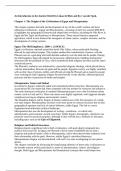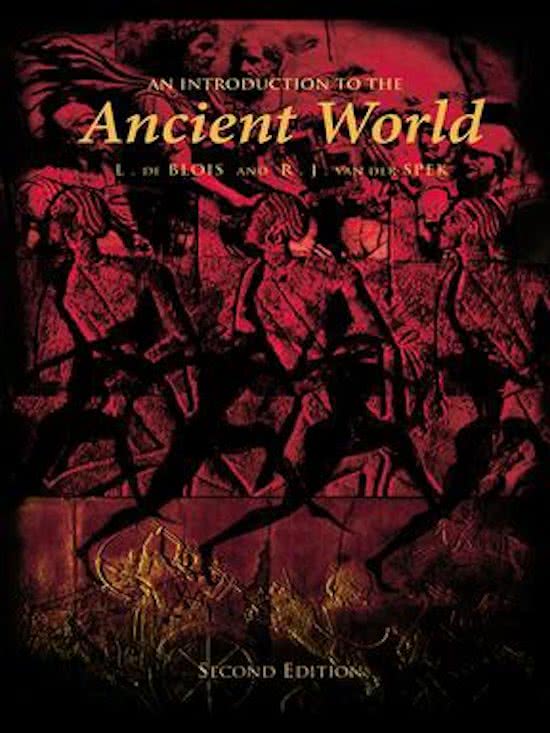An Introduction to the Ancient World by Lukas de Blois and R.J. van der Spek.
Chapter 1: The Origins of the Civilizations of Egypt and Mesopotamia
This chapter explores the birth and development of two of the world’s earliest and most
influential civilizations—Egypt and Mesopotamia—focusing on their rise around 3000 BCE.
It highlights key geographical features that shaped their evolution, including the Nile River in
Egypt and the Tigris and Euphrates in Mesopotamia. These natural features supported
agriculture, which in turn fostered the emergence of urban centers, complex societies, and the
development of writing systems.
Egypt: The Old Kingdom (c. 2600–c. 2150 BCE)
Egypt's civilization centered around the fertile Nile Valley, where predictable flooding
allowed for agricultural surplus. This surplus enabled the centralization of power, with the
Pharaoh seen as a god-king who held absolute authority over the land and its people. During
the Old Kingdom, Egypt developed its bureaucratic administration, building monumental
structures like the pyramids of Giza, which symbolized both religious devotion and the state's
centralized power.
The Pharaoh’s authority was bolstered by a powerful religious ideology, which placed him as
a divine intermediary between the gods and the people. Egyptian society was highly stratified,
with an elite class of priests, nobles, and officials serving the Pharaoh and a majority peasant
class working the land. Egyptian religion focused heavily on the afterlife, influencing burial
practices and the construction of tombs and temples.
Mesopotamia: Sumer and Akkad
In contrast to Egypt’s relatively stable and centralized political structure, Mesopotamia was
characterized by city-states that often competed with one another for resources and influence.
The early Sumerian civilization in southern Mesopotamia gave rise to the first known urban
centers, such as Uruk and Ur. These city-states were highly organized, with ziggurats (temple
complexes) serving as religious and economic centers.
The Akkadian Empire, led by Sargon of Akkad, marked one of the first instances of a multi-
city-state empire. Mesopotamian societies were more prone to external invasions due to their
geographical openness and lack of natural defenses, unlike Egypt. This led to a more
fragmented and militaristic political landscape.
Mesopotamia also saw the development of writing—cuneiform—in which early
administrative and economic records were kept. Unlike Egypt’s hieroglyphs, cuneiform was
primarily used for practical purposes, although it later evolved into a medium for literature,
including epics such as the Epic of Gilgamesh.
Religious and Political Structures
Religion played a significant role in both civilizations, with gods deeply integrated into
political and social life. In Egypt, the Pharaoh’s divine status established him as both a
religious and political leader, while in Mesopotamia, rulers often derived their authority from
their relationship with the gods. However, unlike Egypt’s centralized theocracy,
Mesopotamian religion was decentralized, with each city-state worshipping its own patron
deities.
The chapter concludes by discussing the long-lasting influence of these early civilizations on
the broader ancient world, particularly in terms of administration, culture, and religious
thought. Both Egypt and Mesopotamia laid foundational concepts that would shape later
,civilizations, including the idea of divine kingship, centralized bureaucracy, and monumental
architecture.
Chapter 2: The Third Millennium
The third millennium BCE marked a period of significant development in both Egypt and
Mesopotamia, known as the Early Bronze Age. This chapter explores how these civilizations
evolved, focusing on political structures, religious institutions, economic foundations, and the
key events that defined this period.
Egypt: The Old Kingdom (c. 2600–2150 BCE)
During the Old Kingdom, Egypt solidified its identity as a unified state under the leadership
of a central authority—the Pharaoh. The Pharaoh was regarded as a god-king, a divine ruler
who ensured the harmony between the gods and the people. The Old Kingdom is particularly
noted for its monumental architecture, most famously the pyramids of Giza, which served as
tombs for the Pharaohs and symbols of their power.
Pharaohs and Pyramid Building
The construction of pyramids reached its zenith during the reign of Cheops (Khufu), who
commissioned the Great Pyramid at Giza. These structures reflected not only the religious
beliefs of the Egyptians, particularly their focus on the afterlife but also the vast resources and
labor forces that the Pharaohs commanded. The building of the pyramids was a testament to
the centralized administrative system in place, which could mobilize thousands of workers,
manage supplies, and maintain a stable food supply.
The Egyptian state was highly organized, with a complex bureaucracy that managed the
redistribution of agricultural surplus. This was essential in maintaining the loyalty of the elites
and ensuring the stability of the state. The vizier, the Pharaoh's chief minister, played a crucial
role in overseeing this bureaucracy, ensuring that taxes were collected and public works were
completed.
Religious Practices and Society
Religion during the Old Kingdom was intricately linked to governance. The Egyptians
believed that the Pharaoh was responsible for maintaining Ma'at, the concept of cosmic order
and balance. The state’s religious institutions were well-funded and played a significant role
in everyday life, with temples functioning as centers of economic activity as well as worship.
The priesthood held considerable influence, although the Pharaoh remained the ultimate
authority.
The social structure in Egypt was rigidly hierarchical. At the top were the Pharaoh and the
royal family, followed by nobles, priests, and officials who managed the state's affairs. Below
them were artisans, laborers, and farmers, who made up the majority of the population.
Although there was a clear social hierarchy, the relatively stable nature of Egyptian society
during this period allowed for advancements in culture, art, and architecture.
The Decline of the Old Kingdom
The Old Kingdom eventually fell into decline due to a combination of factors. Around 2200
BCE, a period of drought, known as the First Intermediate Period, led to a breakdown in
central authority. The Nile’s annual flooding became less predictable, which caused
widespread famine. In addition to environmental factors, the increasing power of regional
governors, or nomarchs, weakened the Pharaoh’s control, leading to internal strife and the
eventual collapse of centralized governance.
, Mesopotamia: Sumer and Akkad
While Egypt was forging a unified state, Mesopotamia was developing along more
fragmented lines, with numerous city-states emerging in the fertile region between the Tigris
and Euphratesrivers. The Sumerian civilization was one of the earliest to develop, with cities
like Uruk, Ur, and Lagash becoming major centers of power. These city-states were often in
competition with one another for resources, leading to frequent conflicts.
Sumerian City-States
Sumerians are credited with many firsts in human history, including the development
of cuneiform writing, which was initially used for keeping records of agricultural
transactions. Each city-state was centered around a ziggurat, a large temple complex that
served as both a religious and economic hub. The temples housed the city’s patron god or
goddess, and priests played an essential role in managing the city’s affairs, especially its
economy.
The political structure in Sumer was based on a system of kingship, with each city-state ruled
by a lugal (king) who was responsible for maintaining the city’s defenses and leading its
armies. However, these kings were often challenged by the powerful priestly class, which held
considerable sway due to its control over religious rituals and temple wealth.
The Rise of the Akkadian Empire
The most significant political development during this period was the rise of the Akkadian
Empire, led by Sargon of Akkad around 2334 BCE. Sargon managed to unite the various
city-states of Mesopotamia into the first known empire, stretching from the Persian Gulf to
the Mediterranean Sea. His empire was based on a centralized administration, with Akkad as
its capital.
Sargon’s empire marked a shift in Mesopotamian politics, from the relatively isolated city-
states of the Sumerians to a more integrated and expansive system of governance. The
Akkadian Empire was maintained through a combination of military might and strategic
alliances. Sargon’s successors, including his grandson Naram-Sin, continued his legacy of
expansion, although the empire eventually weakened under internal pressures and external
invasions.
Religious and Economic Life
Religion in Mesopotamia was polytheistic, with a pantheon of gods associated with natural
forces and city-states. The gods were believed to control the fate of the people, and rituals
were conducted to appease them, particularly in times of crisis such as droughts or floods.
Unlike Egypt, where the Pharaoh was seen as a god on earth, Mesopotamian kings were
viewed as intermediaries between the gods and the people.
Economically, Mesopotamia was a hub of trade due to its central location between the
Mediterranean and the Persian Gulf. Its agricultural economy was bolstered by advances in
irrigation, which allowed for the cultivation of wheat, barley, and other crops. Trade routes
extended into Anatolia, the Levant, and the Indus Valley, bringing goods such as timber,
metals, and luxury items into the region.
The Fall of Akkad
Like the Old Kingdom in Egypt, the Akkadian Empire eventually fell into decline. Around
2150 BCE, invasions by the Gutians, a group from the Zagros Mountains, weakened the
empire. In addition to external invasions, internal strife and economic difficulties contributed






